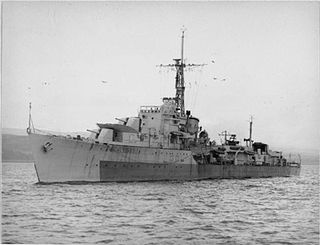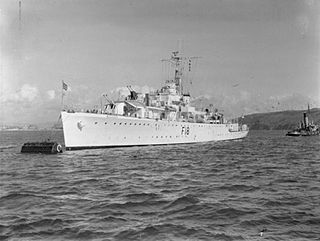
HMS Black Swan, was the name ship of the Black Swan-class sloops of the Royal Navy. This class was admired for its sea-going qualities.

HMS Zebra was a Z-class destroyer. She was to have been named HMS Wakeful but was renamed in January 1943 before launching. The destroyer was launched on 18 March 1944 at William Denny & Brothers shipyard in Dumbarton, Scotland and commissioned on 13 October 1944. She was 'adopted' by the civil community of Urmston, then in the county of Lancashire.

The C class was a class of 32 destroyers of the Royal Navy that were launched from 1943 to 1945. The class was built in four flotillas of 8 vessels, the "Ca", "Ch", "Co" and "Cr" groups or sub-classes, ordered as the 11th, 12th, 13th and 14th Emergency Flotillas respectively. The sub-class names are derived from the initial 2 letters of the member ships' names, although the "Ca" class were originally ordered with a heterogeneous mix of traditional destroyer names. A fifth flotilla, the "Ce" or 15th Emergency Flotilla, was planned but were cancelled in favour of the Weapon-class destroyers after only the first two ships had been ordered. The pennant numbers were all altered from "R" superior to "D" superior at the close of World War II; this involved some renumbering to avoid duplications.

The Black Swan class and Modified Black Swan class were two classes of sloop of the Royal Navy and Royal Indian Navy. Twelve Black Swans were launched between 1939 and 1943, including four for the Royal Indian Navy; twenty-five Modified Black Swans were launched between 1942 and 1945, including two for the Royal Indian Navy; several other ships were cancelled.

HMS Grenville was the second ship of this name to serve with the Royal Navy in the Second World War. Grenville and seven other U-class destroyers were ordered as part of the Emergency Programme. She was launched at Swan Hunter and Wigham Richardson Ltd., Wallsend-on-Tyne on 12 October 1942 and commissioned on 27 May 1943.

HMS Termagant was a T-class destroyer of the Royal Navy that saw service during the Second World War. She was built by William Denny and Brothers, of Dumbarton and launched on 22 March 1943. She was scrapped in 1965.

HMS Magpie, pennant number U82, was a Royal Navy Modified Black Swan-class sloop launched in 1943 and broken up in 1959. She was the seventh Royal Navy ship to bear the name. She was reclassified as a frigate in 1947, receiving a new pennant number F82. The ship was the only vessel commanded by Prince Philip, Duke of Edinburgh, who took command on 2 September 1950, when he was 29.

The Bittern-class sloop was a three-ship class of long-range escort vessels used in the Second World War by the Royal Navy.

HMS Mermaid was a Modified Black Swan-class sloop of the Royal Navy. Mermaid saw service as a convoy escort during the Second World War, taking part in the sinking of two German submarines while escorting Arctic convoys to and from the Soviet Union.

HMS Flamingo was a Black Swan-class sloop of the Royal Navy. She saw service as a convoy escort during the Second World War, seeing extensive service in the Mediterranean and Far East in 1945.

HMS Hart was a modified Black Swan-class sloop of the Royal Navy. She saw service as a convoy escort during the Second World War, seeing service in the Atlantic, Mediterranean and Far East in 1945. She also took part in the Korean War in 1950 and 1951.

HMS Alacrity was a modified Black Swan-class sloop of the Royal Navy. She was built for service as a convoy escort during the Second World War, but was completed too late to see action. She did subsequently take part in the Korean War between 1950 and 1952. She was scrapped in 1956.

HMS Peacock was a modified Black Swan-class sloop of the Royal Navy. She was built for service as a convoy escort during the Second World War, serving in the arctic and Atlantic convoys. After the Second World War she saw service in the Mediterranean. She was scrapped in 1958.

HMS Fleetwood was a Grimsby-class sloop of the Royal Navy. Built at Devonport Dockyard in the 1930s, Fleetwood was launched in March 1936 and commissioned in November that year. She served in the Red Sea until the outbreak of the Second World War. Fleetwood served as a convoy escort during the war, which she survived, and sank the German submarines U-528 and U-340. Post-war, the ship served as a radar training ship, remaining in use until 1959, when she was scrapped.

HMS Lapwing (U62) was a modified Black Swan-class sloop of the Royal Navy.

HMS Actaeon was a modified Black Swan-class sloop built for the Royal Navy during the Second World War. She was completed too late for service in that conflict, but served on the South Africa station in the post-war era.

HMS Modeste was a modified Black Swan-class sloop of the British Royal Navy. She was built by Chatham Dockyard, during the Second World War, being launched on 29 January 1944 and commissioned on 3 September 1945. Post war, Modeste served with the British Far East Fleet, and took part in the Suez Crisis. She was paid off into reserve for the last time in 1958 and scrapped in 1961.

HMS Crane was a modified Black Swan-class sloop of the Royal Navy. She was laid down by William Denny and Brothers, Dumbarton on 13 June 1941, launched on 9 November 1942 and commissioned on 10 May 1943, with the pennant number U23. She saw active service during the Second World War, initially performing convoy escort roles in the Atlantic before supporting the Normandy landings. In the final months of the war, Crane joined the British Pacific Fleet and saw service during the Battle of Okinawa. Post-war, Crane remained in south-east Asia and took part in hostilities during the Korean War. She was redeployed to the Middle East during the Suez Crisis before returning to Asia for service during the Malayan Emergency. Crane was withdrawn from service in the early 1960's and was scrapped in 1965.
HMS Snipe was a modified Black Swan-class sloop of the Royal Navy. She was laid down by William Denny and Brothers, Dumbarton on 21 September 1944, launched on 20 December 1945 and commissioned on 9 September 1946, with the pennant number U20.
HMS Sparrow was a modified Black Swan-class sloop of the Royal Navy. She was laid down by William Denny and Brothers, Dumbarton on 30 November 1944, launched on 16 February 1946 and commissioned on 16 December 1946, with the pennant number U71.
















